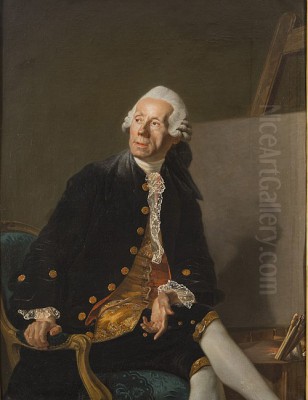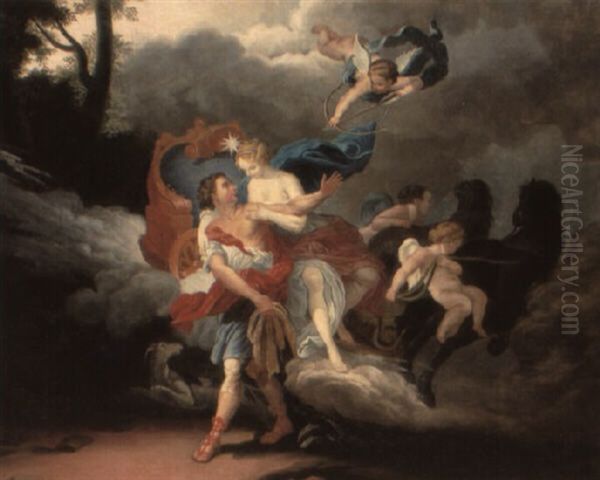
Noel Hallé (1711-1781) stands as a significant, albeit sometimes overlooked, figure in the rich tapestry of eighteenth-century French art. Born in Paris into a lineage steeped in artistic tradition, Hallé navigated the shifting styles and demands of his era, leaving behind a substantial body of work encompassing painting and printmaking. His career reflects the importance of family networks, academic institutions, and state patronage in shaping the life of an artist during the Ancien Régime.
An Artistic Heritage
The Hallé family name was already established in the Parisian art world before Noel's birth. His father, Daniel Hallé (1654-1736), and his uncle, Claude-Guy Hallé (1652-1736), were respected painters active primarily in the late seventeenth and early eighteenth centuries. They specialized largely in religious scenes, contributing to the grand tradition of French religious painting that had flourished under artists like Charles Le Brun in the previous century. This familial environment undoubtedly provided Noel with his initial exposure to art and the technical foundations of painting. Inheriting this legacy, Noel Hallé would primarily build his reputation on historical and religious subjects, continuing the family's engagement with grand manner painting.
Formative Years and the Prix de Rome
While details of his earliest training remain somewhat sparse, it is known that Hallé initially pursued studies in architecture before fully committing to painting. He received instruction from his father, Daniel Hallé, and crucially, also studied under his future father-in-law, Jean Restout II (1692-1768). Restout himself was a prominent history painter and a nephew of the celebrated artist Jean Jouvenet (1644-1717), further embedding Noel within a network of influential history painters. This connection to Restout, a major figure bridging the late Baroque and Rococo styles, was undoubtedly formative.

A pivotal moment in Hallé's early career came in 1736 (some sources suggest 1737) when he won the prestigious Prix de Rome. This coveted award, granted by the Académie Royale de Peinture et de Sculpture (Royal Academy of Painting and Sculpture), provided winners with a funded period of study at the French Academy in Rome. This represented the pinnacle of artistic training for aspiring French artists, offering direct exposure to classical antiquity and the masterpieces of the Italian Renaissance and Baroque periods.
The Roman Sojourn: Exposure and Development
Hallé resided at the French Academy in Rome, then under the directorship of figures like Nicolas Vleughels and later Jean-François de Troy, from approximately 1737 to 1740 (or slightly later, depending on the exact timing of his prize and departure). This period was crucial for his artistic development. Immersed in the artistic riches of Rome, he dedicated himself to studying and sketching the city's ancient ruins and the works of the Old Masters.
A significant undertaking during this time was his copy of Raphael's powerful fresco, The Expulsion of Heliodorus from the Temple, located in the Vatican Stanze. Copying works by masters like Raphael was a standard and essential part of academic training, allowing artists to analyze composition, form, and technique firsthand. This exercise would have deepened Hallé's understanding of classical composition and dramatic narrative, elements vital for a history painter. Sources also indicate he created designs for silk tapestries, possibly intended for the renowned Gobelins Manufactory in Paris, and produced numerous drawings capturing the essence of Roman art and architecture.
Academic Ascent and Recognition in Paris
Upon his return to Paris, Hallé sought recognition within the established structure of the Académie Royale. In 1746, he was approved ('agréé') by the Academy, a crucial step towards full membership. His reception piece for this stage was The Dispute between Minerva and Neptune over the Naming of Athens. This work, showcasing his ability to handle complex mythological narratives with compositional skill and learned references, reportedly earned him considerable praise within the Parisian art world.
Full membership ('reçu') followed in 1748, cementing his status as a recognized master. This academic success opened doors to further opportunities and responsibilities. Hallé became an active participant in the Academy's functions, serving as a councilor and later as its secretary. His commitment to the institution was further demonstrated in 1755 when he was appointed as a professor, entrusted with educating the next generation of artists. His teaching role placed him alongside other influential academicians of the time, such as Carle Van Loo (1705-1765), who dominated the Academy for much of the mid-century.
Style, Themes, and Techniques
Noel Hallé's artistic output primarily focused on religious and historical subjects, aligning with the highest genre in the academic hierarchy. He received commissions from the Crown, the Church, and private patrons, producing altarpieces, mythological scenes, and allegorical works. His style reflects the transitional nature of the mid-eighteenth century. While rooted in the grand tradition inherited from the seventeenth century and reinforced by his Roman studies, his work also displays characteristics associated with the prevailing Rococo aesthetic.
Critics and historians note the influence of Rococo in his use of brighter, higher-keyed color palettes and lighter tones compared to the more somber palettes of earlier Baroque masters. However, his compositions often retained a sense of structure and clarity, perhaps influenced by his training under Restout and his study of Raphael and the classical tradition. He avoided the overt frivolity sometimes associated with artists like François Boucher (1703-1770) or Jean-Honoré Fragonard (1732-1806), maintaining a degree of seriousness appropriate to his preferred subjects. His draftsmanship was noted for its fineness and precision, contributing to the overall elegance and refinement characteristic of French art of the period.
Beyond painting, Hallé was also proficient in printmaking, particularly etching and engraving. This allowed him to disseminate his compositions more widely. Prints like The Death of Seneca and Cornelia, Mother of the Gracchi demonstrate his skill in translating complex painted compositions into the linear medium of print, tackling stoic Roman themes popular during the Enlightenment. Technical details, such as his use of linen canvas weighing between 180 and 280 grams per square meter for works like the Dispute of Minerva and Neptune (a fairly standard weight for the period), provide insight into his material practices.
Notable Works
Several specific works help illustrate Hallé's artistic range and capabilities:
The Dispute between Minerva and Neptune over the Naming of Athens (1746): His reception piece for the Academy, demonstrating his mastery of mythological narrative and complex figure arrangement. It established his reputation upon his return from Rome. A later mention of a work with this title dated 1758 might refer to a different version, a related commission, or a confusion in records, but the 1746 painting remains the key academic work.
La Sainte Famille (The Holy Family) (1753): Exemplifies his work in religious painting, likely showcasing a tender yet dignified treatment of the subject, possibly blending traditional iconography with the softer sentiments of the Rococo era.
Bacchanale (1759): Indicates his engagement with mythological themes of a more exuberant nature, allowing for dynamic compositions and perhaps a richer exploration of movement and flesh tones, common in depictions of Bacchic revels since Titian.
The Death of Seneca and Cornelia, Mother of the Gracchi (Prints): These works highlight his activity as a printmaker and his interest in subjects drawn from Roman history, emphasizing virtue, stoicism, and republican ideals that resonated with Enlightenment thought.
Copy of Raphael's Expulsion of Heliodorus: While a student work, its execution demonstrates his engagement with High Renaissance masters and his dedication to academic principles during his time in Rome.
These works, alongside numerous others for churches (like Saint-Sulpice in Paris) and royal residences, solidify his position as a versatile and productive artist catering to the main sources of patronage in his time.
Later Career: Administration and Honors
Hallé's career extended beyond the studio and the Academy's teaching halls. His administrative talents and respected position led to significant appointments. In 1770, he was named Superintendent ('Directeur') of the prestigious Gobelins Manufactory. This royal institution produced luxurious tapestries, often based on designs by leading painters, for the French Crown and aristocracy. His role involved overseeing artistic production and maintaining the high standards of this important state enterprise.
Furthermore, Hallé was involved in the administration and potential reorganization of the French Academy in Rome, the very institution where he had studied decades earlier. His dedication and service did not go unrecognized. He was eventually granted a title of nobility and awarded the Order of Saint Michael (Chevalier de l'Ordre de Saint-Michel), honors that recognized his significant contributions to the arts and the French state. His career culminated in a prestigious administrative post outside the purely artistic realm: in 1781, the year of his death, he served as the Chief Officer of the Royal Treasurer ('premier officier du comptant du Trésor royal').
Artistic Network and Context
Hallé operated within a dense network of artistic relationships, primarily established through family. His father Daniel and uncle Claude-Guy provided his initial artistic environment. His marriage connected him to Jean Restout II, a major painter and academician. Restout's own lineage linked back to Jean Jouvenet, another key figure of the previous generation. This Hallé-Restout-Jouvenet connection formed a significant bloc within the Parisian art world, particularly strong in the domain of history and religious painting during the first half of the eighteenth century.
His contemporaries at the Academy included the aforementioned Carle Van Loo, François Boucher, Charles-Joseph Natoire (1700-1777, who also served as Director of the French Academy in Rome), and Jean-Baptiste Pierre (1714-1789), who eventually succeeded Boucher as First Painter to the King. Hallé's career unfolded during a period of stylistic transition. While influenced by the Rococo, his work often maintained a connection to the classical tradition, positioning him somewhat differently from the more purely decorative impulses of Boucher. He can be seen as part of a generation that upheld the values of history painting before the more rigorous Neoclassicism championed by artists like Joseph-Marie Vien (1716-1809) and, more dramatically, Jacques-Louis David (1748-1825) began to take hold towards the end of Hallé's life. His work represents a specific moment in French art, blending late Baroque grandeur with Rococo elegance, before the stylistic revolution of Neoclassicism.
Legacy
Noel Hallé was undeniably one of the important French painters of the eighteenth century. He successfully navigated the academic system, secured prestigious commissions, and held significant administrative posts. His work, primarily in history and religious painting, upheld the traditions of the French grand manner while adapting to the lighter palettes and sensibilities of the Rococo era. He was a respected professor and administrator, contributing significantly to the institutional framework of French art.
While perhaps overshadowed in popular memory by more flamboyant Rococo artists like Boucher or Fragonard, or by the revolutionary Neoclassicism of David, Hallé's career and oeuvre are essential for understanding the complexities of French art in the mid-eighteenth century. He represents the continuation of a strong family tradition in painting and the successful career path available through the Royal Academy and state patronage. His paintings and prints, found in museums and collections in France and internationally, remain testaments to his skill, diligence, and significant position within the artistic landscape of his time. Though perhaps not fully appreciated during all periods following his death, contemporary scholarship increasingly recognizes his role as a key figure bridging artistic traditions during a dynamic century of change.